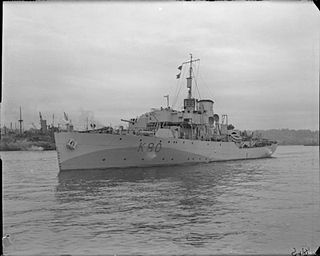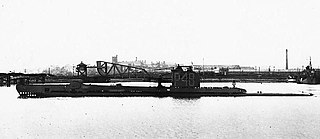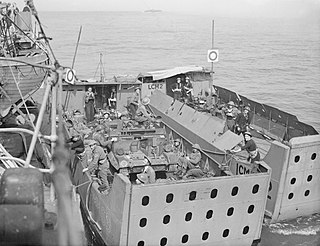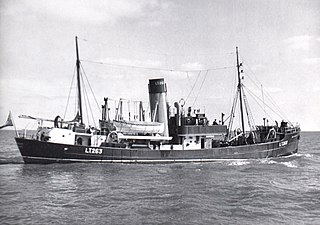
Juno and or Juno Beach was one of five beaches of the Allied invasion of German-occupied France in the Normandy landings on 6 June 1944 during the Second World War. The beach spanned from Courseulles, a village just east of the British beach Gold, to Saint-Aubin-sur-Mer, and just west of the British beach Sword. Taking Juno was the responsibility of the First Canadian Army, with sea transport, mine sweeping, and a naval bombardment force provided by the Royal Canadian Navy and the British Royal Navy as well as elements from the Free French, Norwegian, and other Allied navies. The objectives of the 3rd Canadian Infantry Division on D-Day were to cut the Caen-Bayeux road, seize the Carpiquet airport west of Caen, and form a link between the two British beaches on either flank.

Omaha Beach was one of five beach landing sectors of the amphibious assault component of Operation Overlord during the Second World War.

HMS Bluebell was a Flower-class corvette that served in the Royal Navy in World War II. Ordered from Fleming & Ferguson of Paisley, Scotland on 27 July 1939, she was launched on 24 April 1940 and commissioned in July 1940. She served in the Atlantic, Mediterranean and Arctic campaigns, escorting several convoys to Russia, and also took part in the invasions of Sicily and France. She was torpedoed and sunk by U-711 in the Kola Inlet on 17 February 1945 while escorting the convoy RA 64 from Murmansk. Only one member of her crew survived.

John I. Thornycroft & Company Limited, usually known simply as Thornycroft, was a British shipbuilding firm founded by John Isaac Thornycroft in Chiswick in 1866. It moved to Woolston, Southampton, in 1908, merging in 1966 with Vosper & Company to form one organisation called Vosper Thornycroft. From 2002 to 2010 the company acquired several international and US-based defence and services companies, and changed name to the VT Group. In 2008 VT's UK shipbuilding and support operations were merged with those of BAE Systems to create BVT Surface Fleet. In 2010 remaining parts of the company were absorbed by Babcock International who retained the UK and international operations, but sold the US based operations to the American Jordan Company, who took the name VT Group.

Landing Craft Assault (LCA) was a landing craft used extensively in World War II. Its primary purpose was to ferry troops from transport ships to attack enemy-held shores. The craft derived from a prototype designed by John I. Thornycroft Ltd. of Woolston, Hampshire, UK. During the war it was manufactured throughout the United Kingdom in places as various as small boatyards and furniture manufacturers.

A landing ship, infantry (LSI) or infantry landing ship was one of a number of types of British Commonwealth vessels used to transport landing craft and troops engaged in amphibious warfare during the Second World War. LSIs were operated by the Royal Navy, British Merchant Navy, Royal Canadian Navy, Royal Indian Navy, and Royal Australian Navy. They transported British Commonwealth and other Allied troops in sea assaults and invasions throughout the war.

The Landing Craft Infantry (LCI) were several classes of landing craft used by the Allies to land large numbers of infantry directly onto beaches during World War II. They were developed in response to a British request for seagoing amphibious assault ships capable of carrying and landing substantially more troops than their smaller Landing Craft Assault (LCA). The result was a small steel ship that could land 200 men, traveling from rear bases on its own bottom at a speed of up to 15 knots.

Empire Battleaxe was a British ship of the Second World War and as HMS Donovan in service with the Royal Navy just after the Second World War. Built as a Type C1-S-AY1 Landing Ship, Infantry named Cape Berkeley she then saw merchant service as Empire Battleaxe before being commissioned into the Royal Navy as HMS Empire Battleaxe and then Donovan. After she was decommissioned she returned to merchant service as Empire Battleaxe and was returned to the USA where she was renamed Cape Berkeley once again. A proposed sale in 1948 to China and renaming to Hai C fell through and she was scrapped in 1966.

The Mediterranean U-boat Campaign lasted from about 21 September 1941 to 19 September 1944 during the Second World War. Malta was an active British base strategically located near supply routes from Europe to North Africa. Axis supply convoys across the Mediterranean Sea suffered severe losses, which in turn threatened the fighting ability of the Axis armies in North Africa. The Allies were able to keep their North African armies supplied. The Kriegsmarine tried to isolate Malta but later it concentrated its U-boat operations on disrupting Allied landing operations in southern Europe.
HMS Tremadoc Bay was a Bay-class anti-aircraft frigate of the British Royal Navy, named for Tremadoc Bay in north Wales.

German submarine U-625 was a Type VIIC U-boat of Nazi Germany's Kriegsmarine during World War II. The submarine was laid down on 28 July 1941 at the Blohm & Voss yard in Hamburg, launched on 15 April 1942, and commissioned on 4 June 1942 under the command of Oberleutnant zur See Hans Benker.

HMS P48 was a Royal Navy U-class submarine built by Vickers-Armstrong at Barrow-in-Furness. Commissioned on 18 June 1942, she spent most of her career in the Mediterranean Sea.

HMS Sainfoin was a landing ship, infantry of the Royal Navy that was built in 1943 by Consolidated Steel Corporation, Wilmington, California, United States as the merchant vessel Cape Washington. She was transferred to the Ministry of War Transport in 1944 and renamed Empire Crossbow. Later that year, she was requisitioned by the Royal Navy and commissioned as HMS Sainfoin, with the pennant number F183. In 1946, she was returned to merchant service as Empire Crossbow. She was transferred to the United States in 1947 and renamed Cape Washington. The ship was then laid up until scrapped in 1964.
HMS Sansovino was an infantry landing ship in service with the Royal Navy during the late stages of the Second World War.

HMS Empire Spearhead was a Type C1-S-AY-1 Infantry Landing Ship (LSI) chartered by the British Ministry of War Transport (MoWT) during World War II. She was built by Consolidated Steel Corporation, Wilmington, California. She was launched as Cape Girardeau and completed as Empire Spearhead. In 1945, she was transferred to the Royal Navy and was later renamed HMS Ormonde. Later that year she was transferred back to the MoWT and renamed Empire Spearhead. In 1947, she was transferred to the United States Maritime Commission and renamed Cape Girardeau. The ship was laid up in 1950 and renamed Empire Spearhead. She was scrapped in 1966.

The Landing Craft, Mechanised Mark 1 or LCM (1) was a landing craft used extensively in the Second World War. Its primary purpose was to ferry tanks from transport ships to attack enemy-held shores. Ferrying troops, other vehicles, and supplies were secondary tasks. The craft derived from a prototype designed by John I. Thornycroft Ltd. of Woolston, Hampshire, UK. During the war it was manufactured in the United Kingdom in boatyards and steel works. Constructed of steel and selectively clad with armour plate, this shallow-draft, barge-like boat with a crew of 6, could ferry a tank of 16 long tons to shore at 7 knots (13 km/h). Depending on the weight of the tank to be transported the craft might be lowered into the water by its davits already loaded or could have the tank placed in it after being lowered into the water.

HM LCT 7074 is the last surviving Landing Craft, Tank (LCT) in the UK. LCT 7074 is an amphibious assault ship for landing tanks, other vehicles and troops on beachheads. Built in 1944 by Hawthorn Leslie and Company, Hebburn, the Mark 3 LCT 7074 was part of the 17th LCT Flotilla during Operation Neptune in June 1944.

L'Escarmouche was a River-class frigate in the service of the Free French Naval Forces (FFNL) during World War II. Launched as HMS Frome in 1943, the ship was transferred to the Free French Naval forces and served in the postwar French Navy until her decommissioning in 1960.

RV Sir Lancelot (LT263) was a fisheries research vessel that was operated by the Directorate of Fisheries, now known as the Centre for Environment, Fisheries and Aquaculture Science (Cefas).





















